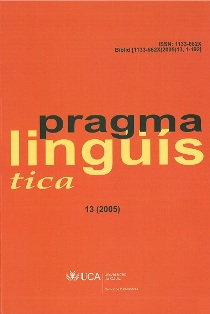Mentiras, relevancia y teoría de la mente

DOI
https://doi.org/10.25267/Pragmalinguistica.2005.i13.03Información
Resumen
Mentir intencionadamente es una de las características más salientes de nuestra especie. En este artículo discutimos cuáles son las herramientas cognitivas necesarias para el arte de mentir y manipular al otro. Concretamente argumentaremos que, además del módulo lingüístico, es necesaria la capacidad de atribuir estados mentales al otro. Dicha capacidad sería el resultado de un módulo cognitivo complejo en el que están incluidos, entre otras habilidades, el principio de relevancia (Sperber y Wilson 1986/1995), la habilidad de asignar estados mentales a otros recursivamente (Perner y Wimmer, 1985) y el mecanismo de detección de tramposos (Cosmides, 1989; Tobby y Cosmides, 1989, 1992, 2000).
Palabras clave
Descargas
Cómo citar
Licencia
Derechos de autor 2018 Pragmalingüística

Esta obra está bajo una licencia internacional Creative Commons Atribución-NoComercial-CompartirIgual 4.0.
Citas
BARON-COHEN, S. (1995), Mindblindness: An Essay on Autism and Theory of Mind Cambridge, MA, MIT Press
BARON-COHEN, S.; LESLIE, A My FRITH, U. (1985), "Does the autistic child have a 'theory of mind"?", Cognition, 21, 37-46.
BEJARANO, T. (1995), "Articulación Remática y Teoría de la Mente", Actas del XI Congreso de Lenguajes Naturales y Lenguajes Formales, Barcelona, España. Promo-ciones y Publicaciones Universitarias, 191-204.
BEJARANO, T. (2000), "Interrogación Interpersonal, Preguntas a la Naturaleza y "Teoría de la Mente", Actas de las Primeras Jornadas Sobre Lógica y Lenguaje, Sevilla, Editorial Kronos, 37-43.
BEJARANO, T (2003), "Metarepresentation and Human Capacities", Pragmatics & Cognition, 11, 1, 93-140
BICKERTON, D. (1990), Language & Species, Chicago, University of Chicago Press.
COSMIDES, L. (1989), "The logic of social exchange: Has natural selection shaped how humans reason? Studies with the Wason selection task", Cognition, 31,187-276.
COSMIDES, L., y TOOBY, J. (1989), "Evolutionary psychology and the generation of culture, Part II. Case study: A comparative theory of social exchange", Ethology and sociobiology, 10, 51-97.
COSMIDES, L., y TOOBY, J. (1992), "Cognitive adaptations for social exchange", en JH. Barkow, L. Cosmides, y J. Tooby (Eds.), The adapted mind: evolutionary psychology and the generation of culture, New York, Oxford University Press.
COSMIDES, L. y TOOBY, J. (2000), "Consider the source: The evolution of adaptations for decoupling and metarepresentations", en D. Sperber (ed), Metarepresentations. Oxford, Oxford University Press, 53-115.
ECO, E (1976), A Theory of Semiotics, Bloomington, Indiana University Press.
ESCANDELL, V (2004), "Competencia comunicativa, arquitectura cognitiva y discipli-
nas lingüísticas", ms. Universidad Nacional a Distancia
FODOR, J (1983). The Modularity of Mind, Cambridge, MA: MIT Press.
GERNSBACHER, M. 1995, Handbook of Psycholinguistics, New York, Academic Press. GIGERENZER, G., y HUG, K. (1992), "Domain-specific reasoning: Social contracts, cheating, and perspective change", Cognition, 43, 127-171.
GRICE, H. P. (1957), "Meaning", Philosophical Review, 66, 377-388.
GRICE, H. P. (1975), "Logic and conversation.", en Cole, P. y Morgan (eds.) Syntax and semantics: Speech acts, Vol. 3, New York, Academic Press.
HAUSER, M, CHOMSKY, N. Y FITCH, W.T. (2002), "The faculty of language: what is it, who has it and how did it evolve?", Science, 298, 1569-1579.
HOCKETT, C. F. (1960), "The origin of speech", Scientific American, 203,88-96.
HOCKETT C. y Altman (1968), "A note on design features", en T. A. Sebeok (ed.), Animal communication, Bloomington, Indiana University Press.
LESLIE, A. (1987), "Pretense and representation", Psychological review, 94, 412-426
LESLIE, A, ROTH, D. (1993), What autism teaches us about metarepresentation, Oxford, Oxford University Press.
LORENZO, G. (2006), "Mentes que mienten. Reflexiones sobre los orígenes evolutivos de la prevaricación", conferencia dictada en el seminario Lingua Obscura: Acercamientos Filológicos de la Mentira, Universidad de Sevilla, 6-8 de marzo.
LORENZO Gy V. LONGA (2003), Homo Loquens. Biología y evolución del lenguaje, Lugo, Tris Tram
MITCHELL, R. W. (1986), "Aframework for discussing deception", en R. W. Mitchell y N-S. Thompson (eds.), Deception: perspectives on human and non-human deceit. New York, State University of New York Press.
NÚÑEZ, M. Y A. RIVIÈRE, (1994), "Engaños, intenciones y creencias en el desarrollo y evolución de una psicología natural", Estudios de Psicología, 15, 2, 83-128(46).
ORIGGI, G. y SPERBER, D. 2000, "Evolution, communication and the proper function of language", en P. Carruthers y A Chamberlain (eds) Evolution and the Human Mind: Language, Modularity and Social Cognition, Cambridge, Cambridge University Press, 140-169.
PERNER, J. YWIMMER, H. (1985) "John thinks that Mary thinks that..." Attribution of second-order beliefs by 5- to 10 year-old children. Journal of Experimental Child Psychology. 39, 437-471.
PREMACK, D. y WOODRUFF, G. (1978), "Does the chimpanzee have a theory of mind?" Behavioural and. Brain Sciences. 1, (4) 1, 515-526.
SPERBER, D., CARA, F., y GIROTTO, V. (1995), "Relevance theory explains the selection task". Cognition, 52, 3-39.
SPERBER, D., y GIROTTO, V. (2002), "Use or misuse of the selection task? Rejoinder to Fiddick, Cosmides, and Tooby". Cognition 85,3:277-290.
SPERBER, D. y D. WILSON (1986/1995), Relevance: Communication and Cognition. Oxford, Blackwell.
SPERBER, D. y D. WILSON (2002), "Pragmatics, Modularity y Mind-reading", Mind and Language, 17, 1:3-23.
TOMASELLO, M. (1999), The Cultural Origins of Human Cognition, Cambridge, MA, Harvard University Press.
TOMASELLO, M. (2003) Constructing a Language: A Usage-Based Theory of Language Acquisition. Cambridge, MA, Harvard University Press.
WASON, P. (1966). "Reasoning", en New Horizons in Psychology, Hammondsworth, UK, Penguin.






